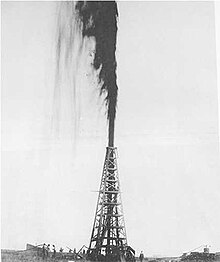Blowout (deep drilling technique)
An uncontrolled escape of drilling fluid , crude oil and / or natural gas from a borehole of a drilling or production system is referred to as blowout . The uncontrolled leakage of gas or oil from a storage cavern can also be described in this way if it takes place violently. Often the oil or gas ignites in a blowout event. The trigger for a blowout event is generally an accident or a military action. Until the 1920s, there were no concepts for preventing blowouts, which were also called “gusher”.
Origin and effects

Oil and natural gas deposits are located under gas and liquid-tight overburden. Due to the load of these rock masses, the gas and liquid bubbles below are under high pressure.
This pressure is compensated for during drilling in that the borehole is filled with drilling fluid of a high density during drilling ; the weight of this column of liquid creates a hydrostatic counter pressure. In the course of oil or gas wells, unexpected pressure increases sometimes occur due to nearby gas or oil reservoirs that press into the well.
This is called a kick and requires an immediate response from the drill crew. A kick can be recognized by pressure measurements and / or by observing the amount of drilling fluid. The most important element for controlling such pressure increases is the blowout preventer , which is mounted as a series of combined shut-off devices directly above the borehole.
If the kick cannot be stopped, a blowout occurs: gas and / or oil flow unhindered into the borehole and "blow out the contents of the borehole". The associated displacement of the loading drilling fluid increasingly exacerbates the imbalance.
The danger of blowouts is that large amounts of natural gas combine with the ambient air to form a highly explosive mixture with the explosive flow of liquid flowing outwards; a spark or hot objects are enough to ignite it. Since oil and gas can now flow in unhindered, a fire that can only be extinguished with great technical effort occurs. The entire drilling rig can be destroyed in a very short time by the explosion and fire.
If a blowout cannot be stopped, large amounts of oil and gas will find their way into the environment in an uncontrolled manner, where at least the oil causes considerable ecological damage.
Blowout events
- Hamm-Pelkum (Germany, June 6, 2018)
- Elgin Wellhead Platform (North Sea, 2012)
- Deepwater Horizon (Gulf of Mexico, 2010)
- Kuwait (Kuwait, 1991), Second Gulf War : The Iraqi military blew up more than 700 oil wells during withdrawal.
- Natural gas leak in the North Sea (Scottish coast, 1990, unstopped to this day)
- Tengiz (Kazakhstan / Soviet Union, 1985)
- Frankenthal (Pfalz, natural gas storage facility , 1980)
- IXTOC I (Gulf of Mexico, 1979)
- Ekofisk Bravo (North Sea, 1977)
- Santa Barbara Oil Spill (California Coast, 1969)
- Marolterode (Thuringia / GDR, 1959)
- Seria (Brunei, June 1945) Second World War : Japanese military ignite 37 oil wells in Seria before they vented.
- Moreni probe (Romania, 1929)
- Lakeview Gusher (California / USA, 1910)
See also
- Deep drilling
- Top kill
- List of major oil spills
- The uncontrolled leakage of large amounts of (contaminated) water from a mine is sometimes referred to as blowout. See the report on such an incident at the "Gold King Mine" in Colorado , USA.
literature
- R. Westergaard: All About Blowout . In: Norwegian Oil Review . 1987, ISBN 82-991533-0-1 .
Web links
- FAZ : "Why it is so difficult to cork the oil leak" (April 27, 2010)
swell
- oilfield.slb.com glossary: blowout
Individual evidence
- ↑ oilfield.slb.com glossary: kick
- ↑ http://lvbb-nrw.de/index.php/aktuelles/218-grubengasaustritt
- ↑ https://www.antenneunna.de/nachrichten/kreis-unna/nachrichten/art749,1542283
- ↑ https://www1.wdr.de/mediathek/video/sendung/aktuelle-stunde/video-gasblase-in-hamm-angebohrt--100.html
- ↑ https://www1.wdr.de/nachrichten/ruhrgebiet/hamm-gasblase-100.html
- ↑ https://www.wa.de/hamm/pelkum-ort370530/tritt-gasleitung-aus-kamener-strasse-hamm-pelkum-gesperr-9929305.html
- ↑ Spiegel article from February 16, 2001
- ^ Article of the DLF on the second Gulf War from August 2, 2015
- ↑ The Santa Barbara Oil Spill: A Retrospective. P. 4 , accessed on May 19, 2016 . Prof. C. Clarke and Graduate Student JJ Hemphill, University of California, Santa Barbara
- ↑ Historical use - natural gas eruption near Malterode. Thuringian Fire Brigade Association - Official Member Information, October 2009, p. 3 , accessed on April 30, 2016 . Note: This quote is again a quote from the magazine "Our Fire Protection" issue 1 from 1960.
- ^ Australian Second World War Official Histories , Volume VII - The Final Campaigns (1st edition, 1963), Chapter 20 - Securing British Borneo, page 485
- ^ Technical Evaluation of the Gold King Mine Incident. US Department of the Interior, October 2015, p. 57 , accessed May 19, 2016 .
